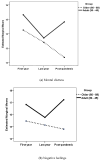COVID-19 and Mental Distress and Well-Being Among Older People: A Gender Analysis in the First and Last Year of the Pandemic and in the Post-Pandemic Period
- PMID: 39846575
- PMCID: PMC11755442
- DOI: 10.3390/geriatrics10010005
COVID-19 and Mental Distress and Well-Being Among Older People: A Gender Analysis in the First and Last Year of the Pandemic and in the Post-Pandemic Period
Abstract
The Coronavirus disease 2019 (COVID-19) pandemic seriously threatened the health and well-being of the population. This study aims to investigate the relevance of the COVID-19 pandemic on the stress, mental distress, and well-being of older people in Spain. The design was quantitative repeated cross-sectional. The sample was non-probability and consisted of 1436 persons from the general population divided into two groups: (1) the study group, composed of 718 women (61.3%) and men aged 60 to 89; (2) the comparison group, composed of the same number of women and men aged 30 to 45. All were assessed in three phases of the COVID-19 pandemic: the first pandemic year, the last pandemic year, and the post-pandemic period. The results showed that during the first year of the pandemic, the prevalence of mental distress was higher in older women (50%) than in older men (37.2%), while the rates in the comparison group were 57.2% for women and 53.2% for men. In the post-pandemic period, the rates of mental distress were 30.2% for older women and 29.8% for older men while in the comparison group, the rates were 48.5% for women and 26.5% for men. No significant differences in well-being were found between the groups or between the different phases of the pandemic. The most common stressors reported by older people were illness and death of family and/or loved ones, followed by personal illness. In the post-pandemic period, more stressful events and lower stress resilience were found to predict mental distress in older women and men. Greater perceived vulnerability to infection was another important predictor for women. Low self-esteem and younger age were also predictors of mental distress for men. High self-esteem, high social support, greater stress resilience and fewer stressful events were predictors of well-being for both genders. The results of this study are relevant for the design of policies, programs, and strategies to improve the health and well-being of older people.
Keywords: Coronavirus disease-2019 (COVID-19); affect balance; gender; life satisfaction; mental distress; older people; social support; stressful events; thriving; well-being.
Conflict of interest statement
The author declares no conflicts of interest.
Figures
Similar articles
-
Stressful Events, Psychological Distress and Well-Being during the Second Wave of COVID-19 Pandemic in Spain: A Gender Analysis.Appl Res Qual Life. 2022 Dec 31:1-29. doi: 10.1007/s11482-022-10140-1. Online ahead of print. Appl Res Qual Life. 2022. PMID: 36619208 Free PMC article.
-
Gender differences in mental distress and affect balance during the first wave of COVID-19 pandemic in Spain.Curr Psychol. 2022 Jun 4:1-15. doi: 10.1007/s12144-022-03282-w. Online ahead of print. Curr Psychol. 2022. PMID: 35693842 Free PMC article.
-
Gender, psychological distress, and subjective well-being two years after the onset of the COVID-19 pandemic in Spain.Cad Saude Publica. 2024 Mar 22;40(3):e00141523. doi: 10.1590/0102-311XEN141523. eCollection 2024. Cad Saude Publica. 2024. PMID: 38536989 Free PMC article.
-
Meaning in Life and Self-Control Buffer Stress in Times of COVID-19: Moderating and Mediating Effects With Regard to Mental Distress.Front Psychiatry. 2020 Sep 23;11:582352. doi: 10.3389/fpsyt.2020.582352. eCollection 2020. Front Psychiatry. 2020. PMID: 33173525 Free PMC article.
-
Impact of COVID-19 pandemic on mental health in the general population: A systematic review.J Affect Disord. 2020 Dec 1;277:55-64. doi: 10.1016/j.jad.2020.08.001. Epub 2020 Aug 8. J Affect Disord. 2020. PMID: 32799105 Free PMC article.
References
-
- World Health Organization WHO Director-General’s Opening Remarks at the Media Briefing on COVID-19—11 March 2020. [(accessed on 25 September 2024)]. 2020. Available online: https://www.who.int/director-general/speeches/detail/who-director-genera....
-
- United Nations WHO Chief Declares End to COVID-19 as a Global Health Emergency. 2023. [(accessed on 27 October 2024)]. Available online: https://news.un.org/en/story/2023/05/1136367.
-
- Fedecostante M., Sabbatinelli J., Dell’Aquila G., Salvi F., Bonfigli A.R., Volpato S., Trevisan C., Fumagalli S., Monzani F., Incalzi R.A., et al. Prediction of COVID-19 in-hospital mortality in older patients using artificial intelligence: A multicenter study. Front. Aging. 2024;5:1473632. doi: 10.3389/fragi.2024.1473632. - DOI - PMC - PubMed
-
- Rizza S., Nucera A., Chiocchi M., Bellia A., Mereu D., Ferrazza G., Ballanti M., Davato F., Di Cola G., Buonomo C.O., et al. Metabolic characteristics in patients with COVID-19 and no-COVID-19 interstitial pneumonia with mild-to-moderate symptoms and similar radiological severity. Nutr. Metab. Cardiovasc. Dis. 2021;31:3227–3235. doi: 10.1016/j.numecd.2021.08.035. - DOI - PMC - PubMed
LinkOut - more resources
Full Text Sources



